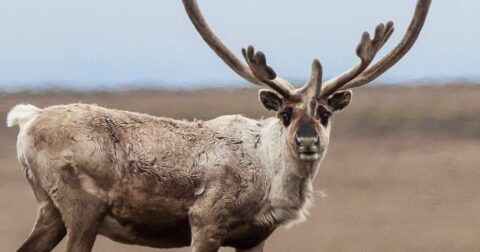Southwest Wisconsin Dairy Operation Linked to Spill Affecting Eight Miles of Trout Waters
Climate•4 min read
Reported
Scientists warn the Willow Project not only damages the atmosphere but also threatens vulnerable wildlife — here are 7 examples.


Words by Marlena Williams
The Biden administration’s decision to greenlight the controversial drilling operation known as the Willow Project has set off alarm bells among climate scientists and environmental groups. Set to unfold across 528 acres of pristine tundra and wetlands in Alaska’s North Slope, the project could pump anywhere from 278 to 287 million metric tons of greenhouse gas pollution into the atmosphere over the next 30 years. But there’s even more at risk, conservation experts warn. The operation could also drive many vulnerable species closer to the brink of extinction — including Steller’s Eiders seaducks, Bowhead whales and Southern Beaufort Sea polar bears.
On March 13th, the Biden administration approved a scaled-down version of the project, shrinking it to three drilling pads from the originally-proposed five and instituting new protections elsewhere in the Arctic. Because the law around oil leases leans strongly in favor of lease holder ConocoPhillips, it’s possible the administration felt they had no choice but to approve the plan. An ongoing legal battle could have cost the government as much as $5 billion dollars in legal fees.
Massive infrastructure development is already underway at the site in the National Petroleum Reserve-Alaska, the nation’s largest piece of public land. As ConocoPhillips begins mining gravel and constructing roads in this sensitive part of the Arctic, a coalition of groups including Earthjustice and the Center for Biological Diversity filed a lawsuit to stop the project from going forward. Most recently, U.S. District Court Judge Sharon Gleason denied an injunction to halt progress, allowing the project to proceed amid the pending litigation.
If allowed to move forward, the Willow Project promises to provide a secure, independent energy supply in the face of an unstable foreign market — as much as 600 billion barrels of oil over 30 years that could generate billions of dollars in economic activity.
Yet the boost in energy reserves comes at a steep cost to animals. “The Willow Project will cause a host of terrible harms to wildlife in the region,” says Kristen Monsell, the Oceans Programs Litigation Director at the Center for Biological Diversity.
The project will expand into previously undeveloped parts of the Alaskan Arctic where many vulnerable species live, breed and migrate. A project of this size and scale could cause dramatic habitat loss and — according to Monsell and other experts — disturb normal animal patterns and behaviors, create noise and light pollution and expose wildlife to dangerous, often life-threatening contaminants from oil spills and other toxic pollutants.
According to a report from the National Oceanic and Atmospheric Administration, loud and continuous underwater or in-air noise from construction and vessel traffic can cause injury and disorientation to nearby animals. The disruption can even cause them and their prey to abandon their habitats — altering ecosystems and eventually wiping out entire populations.
Despite continued improvements in engineering and greater focus on spill prevention and response, spills will still be inevitable during Willow’s three-decade lifespan. According to spill rate estimates produced by the Bureau of Land Management and cited in Earthjustice’s legal complaint, the project is likely to cause approximately four medium-sized oil spills over the course of production, with an average spill size of 9,800 gallons.
And there are other impacts to consider too. Even though oil drilling will not officially start until the fourth year of the project, ConocoPhillips plans to construct over 30 miles of gravel roads in preparation and create up to 700 miles of ice roads as well as bridges, an airstrip, a boat ramp, a 115-acre gravel mine, central oil processing facilities and hundreds of miles of import and export pipelines.
As more activity flows into the project area, the risks of deadly collisions between animals and sea vessels or on-road vehicles increases. Barges and vehicles can collide with polar bears, whales, seals, otters and caribou — putting humans and wildlife alike at risk of injury and even death.
Here are some of the most at-risk species:
Sealift barges delivering construction materials can come in contact with a wide variety of sea mammals, including several species of endangered whales like the only remaining Bowhead whales in the region and North Pacific right whales, whose population is currently believed to be fewer than 500.
The barges will also travel into areas populated by Ringed and Bearded seals — their numbers already vulnerable thanks to climate change and habitat loss.
Northern sea otters in the area — already dwindling thanks to decades of commercial hunting — will also be at risk of injury or death from vessel collisions.
The Willow Project will also bring barges into the Teshekpuk Lake Special Area — a series of interlocking waterways and wetlands that provide prime habitat for 78,000 molting geese and approximately 600,000 shorebirds, including high densities of threatened yellow-billed loons.
Conservation scientists warn the increase in traffic also threatens lakes in the nearby Colville River Special Area. habitat to a variety of fish species, including salmon and whitefish.
The project could also threaten the tens of thousands of caribou in the Teshekpuk Lake Special Area, animals who are an important subsistence hunting resource for nearby Indigenous communities. Willow will disrupt caribou’s normal migration patterns and put them at an increased risk of collisions with trucks and other vehicles.
Perhaps one of the most serious causes for concern is the survival of the Southern Beaufort Sea Polar Bear, a subpopulation of polar bear that has been in a general decline for decades.
The coastline, riverbanks, barrier islands and coastal bluffs of Alaska’s North Slope provide crucial maternal denning sites for these animals, but construction and drilling activities in the area could obstruct the movement of pregnant females in search of dens, or cause mothers to prematurely leave their dens after giving birth, abandoning their young cubs. Vibrations from seismic vehicles could also cause dens to collapse, crushing the polar bears inside of them.
“Noise pollution is especially harmful to polar bears in the region, already struggling to survive in the face of melting sea ice,” adds the Center for Biological Diversity’s Monsell.
Oil spills could also prove harmful — polar bears with oiled fur cannot effectively thermoregulate, which affects their ability to stay insulated in frigid arctic temperatures. The impacts of ingesting oil or eating contaminated prey could cause a relatively mild reaction like hair loss or cause long-term consequences like organ damage, starvation and death.
Despite the clear risks to wildlife in the region, the North Alaska Field Office of the U.S. Fish and Wildlife Service reports that the Willow Project “is not likely to jeopardize the continued existence” of polar bears and other vulnerable species. The National Oceanic and Atmospheric Administration issued a similar report, citing the reduced size of the drilling area, the precise timing of certain drilling and transport activities and the mitigation measures put in place to prevent oil spills and other harms.
However, these reports focus solely on the impact the Willow Project will have in the short term. According to the complaint filed by Earthjustice and other environmental groups, the government reports misrepresent the serious impacts the project will have on both people and wildlife across the globe. Even if the immediate impacts to wildlife in the region prove to be relatively contained, the medium-and-long term impacts will very likely be disastrous.
“The agencies failed to properly examine the threat that the greenhouse gas emissions caused by the project will have on climate-threatened species like polar bears and ringed seals,” says Monsell, adding, “The agency ignored how approving Willow could push these species closer to the brink of extinction.”
Burning fossil fuels is the main driver of climate change worldwide, accounting for over 75 percent of global greenhouse gas emissions and nearly 90 percent of all carbon dioxide emissions. A report from the United States Geological Survey estimates that oil drilling on public land and in federal waters makes up nearly a quarter of the harmful greenhouse gas emissions produced by the United States.
Climate change further accelerates the many threats currently facing wildlife around the world. A 2022 report from the World Wildlife Fund says global wildlife populations have dropped by 69 percent since the 1970s, citing habitat loss, pollution and climate change as the major factors causing this steep decline.
Yet the situation is particularly acute in the Arctic. The region is currently warming four times faster than the rest of the world, a trend that is expected to continue throughout the century. This steady warming has numerous climate consequences — including wildfires, storm surge flooding and perhaps most importantly, melting sea ice.
Arctic sea ice is melting at an alarming rate of about 12.6 percent percent per decade. In 2017, the region experienced the lowest level of sea ice coverage on record. Polar bears depend on sea ice for survival, and disappearing sea ice impacts their ability to hunt, feed, breed, rest, den and travel. The loss of sea ice also poses a threat to key polar prey like ringed and bearded seals.
According to a study produced by the U.S Geological Survey, polar bears will experience a 42 percent loss of their optimal summer habitat by the year 2050. As sea ice declines, more and more polar bears will be forced to move further inland, where the chances of adverse exposure to humans, drilling activities and potential oil spills dramatically increases.
Melting sea ice also tends to bring increases in sea vessel traffic — creating more pollution, displacing wildlife and upping the likelihood of fatal collisions between vessels and marine animals.
Perhaps even worse, the Willow Project could pave the way for even more oil development elsewhere. ConocoPhillips sees Willow as the next great hub for oil production in the U.S. and hopes to use the Willow infrastructure to leverage more drilling operations throughout the region in the future — which would pump out more emissions and threaten even more vulnerable wildlife populations.